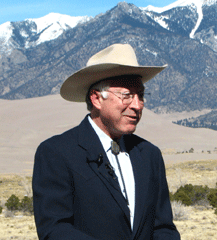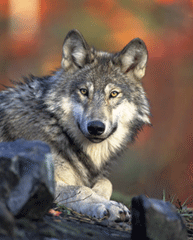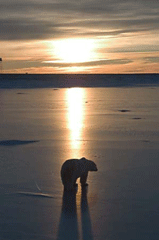The Future of Species Protection
Air Date: Week of May 15, 2009

Interior Secretary Ken Salazar was raised on a cattle and sheep ranch in Colorado. (Photo: Tami Heilemann, DOI-NBC)
The Obama administration's recent decisions on the gray wolf and the polar bear have enraged some environmentalists and could indicate a moderate approach to using the Endangered Species Act. Vermont Law School professor Patrick Parenteau analyzes the politics of protecting endangered species with host Jeff Young.
Transcript
CURWOOD: From the Jennifer and Ted Stanley studios in Somerville, Massachusetts, this is Living on Earth. I’m Steve Curwood.
YOUNG: And I’m Jeff Young in Washington where the Obama administration's energy agenda is running into stiff resistance.
For the first time Senate Republicans got enough votes to block one of the president’s nominees-- David Hayes, Mr. Obama’s choice to become deputy secretary of the Interior Department.
CURWOOD: Republican say it’s nothing personal about Mr. Hayes, who held the same position under President Clinton. It’s really about oil and gas.
Utah Republican Senator Robert Bennett is upset because the Interior Department revoked drilling leases near two national parks in Utah. And Alaska Senator Lisa Murkowski questions if the administration is allowing enough offshore drilling.
MURKOWSKI: Are we making a commitment to increase domestic production in this country, as I believe we should, and as the president himself stated. He said, “oil and gas need to be part of the equation.” But they need to translate those words into action.
CURWOOD: Senate leaders expect Mr. Hayes will eventually be confirmed for the number two spot at interior. But other nomination battles are still brewing, including the top air quality slot at EPA and two senior officials at the energy department.
But Jeff, while Republicans are fighting on the energy front, they must have liked the Administration’s recent ruling about polar bears and wolves.
YOUNG: I imagine so - but some environmental groups do not like those decisions on endangered species.
Interior Department Secretary Ken Salazar is sticking with a Bush-era decision that limits protections for the polar bear. The bear is threatened by melting arctic ice from climate change, but secretary Salazar chose not to use the Endangered Species Act to try to try to limit greenhouse gas emissions. Environmental activists are also taking Secretary Salazar to court for sticking with the Bush plan to remove the gray wolf in the Northern Rockies from the endangered species list.
I spoke to Vermont Law School professor Pat Parenteau who is an expert on the act.
PARENTEAU: I think Secretary Salazar represents a new kind of western voice. For example, oil and gas leasing on public lands – he’s been very critical of that program. But when it comes to endangered species and particularly the management of these large predators like the wolf – I think what we’re seeing is a very old style western politician at work – someone who can’t divorce himself really from the community he grew up in, ranching community. And who is very sympathetic with people in the west who have made their living on the land and for right or wrong who see the intrusion of the federal government into the way the way they manage their lands as something that they want to minimize. So, Salazar is straddling a bit on some of these western issues, and it will be interesting to see how he manages these very conflicted policies that he has to be responsible for within the Department of Interior.

The gray wolf-- no longer an endangered species in the northern Rockies. (Courtesy of the U.S. Fish and Wildlife Service)
PARENTEAU: I think he did. There were other options open to the secretary. He could have crafted a different kind of rule that didn’t rule out the possibility of considering the effects of greenhouse gas emissions on the polar bears, but the Obama administration prefers a comprehensive bill that’s pending in the Congress right now to deal with climate change and really does not want to use the Endangered Species Act to address that major problem. But the Endangered Species Act is designed to address all threats to species and particularly cumulative threats. If you think of the example of water withdrawals and affecting salmon in the pacific northwest, no single water withdrawal threatens the survival of the salmon, but we know now that the combination of all the water withdrawals plus of course pollution and other things, are in fact driving the salmon to extinction. The polar bear is a very similar situation. No one power plant is confusing the Arctic to melt. The combination of all power plants though, most assuredly are causing the Arctic to melt. The only answer to that question is to limit the amount of carbon dioxide coming from power plants and the Endangered Species Act – although it’s no the ideal tool – to address that problem by any means, it is certainly a tool.

Some fear by the time Congress acts on climate change, polar bear populations will have passed the tipping point for their survival. (Photo: Lee Foster)
PARENTEAU: Yes, I think it does set a precedent. They next species in line to be listed as a result of climate change is a species called the pika, which is a small mammal, a rodent like species that lives in very high elevation areas of the west, the Rocky Mountains, for example. And we’re gonna have this – face the same problem there. The science clearly suggests that the species should be listed. Fish and Wildlife Service seems to be moving in that direction, and you’ll have a repeat, I think, of what we saw with the polar bear, which is they’ll list the species and then will immediately issue this rule – it’s called a 4D rule, like they did for the polar bear. And it will say, for example, we are not going to take into account greenhouse gas emissions when we look at threats to the pika.
YOUNG: Now this seems to be kind of an inconsistent argument, that here’s the threat: climate change. And here’s the plan for dealing with it: we’re gonna ignore climate change. If this goes to court, as it most surely will, well –you’re a lawyer – what are the department’s chances of winning there?
PARENTEAU: Well there are cases pending now in federal court in the District of Columbia, and I think the courts may very well over turn this rule and send it back to Secretary Salazar. And it may provide the secretary with a second opportunity to take a look at this situation. But yeah, I think there are strong legal arguments to challenge the explanation that the agency has offered for why the most prominent threat to the polar bear is being excluded from consideration in this special rule that they’ve adopted.
YOUNG: Professor Pat Parenteau specializes in endangered species and climate change issues at Vermont’s Law School. Thanks very much for your time.
PARENTEAU: My pleasure. Thank you, Jeff.
Links
Check out LOE's profile of Secretary Salazar.
Learn more about Patrick Parenteau.
Click here for more on the Interior Department’s polar bear decision….
… and the Department’s delisting of the gray wolf.
For more on the environmental group Defenders of Wildlife, click here.
Living on Earth wants to hear from you!
Living on Earth
62 Calef Highway, Suite 212
Lee, NH 03861
Telephone: 617-287-4121
E-mail: comments@loe.org
Newsletter [Click here]
Donate to Living on Earth!
Living on Earth is an independent media program and relies entirely on contributions from listeners and institutions supporting public service. Please donate now to preserve an independent environmental voice.
NewsletterLiving on Earth offers a weekly delivery of the show's rundown to your mailbox. Sign up for our newsletter today!
 Sailors For The Sea: Be the change you want to sea.
Sailors For The Sea: Be the change you want to sea.
 The Grantham Foundation for the Protection of the Environment: Committed to protecting and improving the health of the global environment.
The Grantham Foundation for the Protection of the Environment: Committed to protecting and improving the health of the global environment.
 Contribute to Living on Earth and receive, as our gift to you, an archival print of one of Mark Seth Lender's extraordinary wildlife photographs. Follow the link to see Mark's current collection of photographs.
Contribute to Living on Earth and receive, as our gift to you, an archival print of one of Mark Seth Lender's extraordinary wildlife photographs. Follow the link to see Mark's current collection of photographs.
 Buy a signed copy of Mark Seth Lender's book Smeagull the Seagull & support Living on Earth
Buy a signed copy of Mark Seth Lender's book Smeagull the Seagull & support Living on Earth

